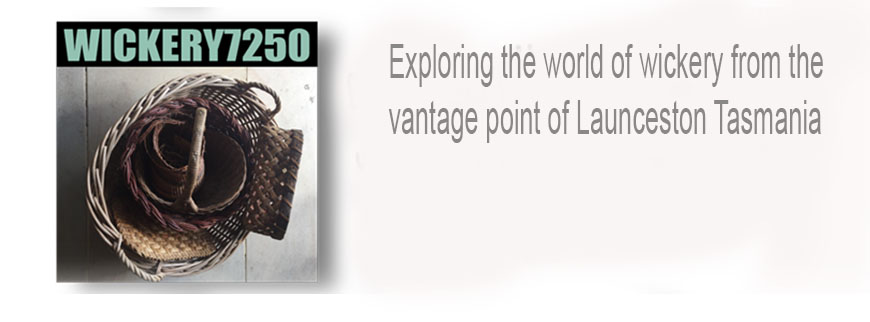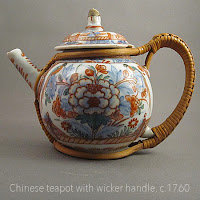Sunday 21 October 2018
Friday 27 April 2018
Sunday 22 April 2018
WICKERY HANDLES
This porcelain teapot was
made in China, c.1750-1770, where it was decorated with flowers and leaves in
blue under glaze. Apparently, soon after it was exported to the Netherlands, with
simple blue and white decoration fell out of favour, and more colourful designs
were the new trend. To satisfy the demand, it seems that this teapot was
overpainted in red, green, black, and gold enamels. Amsterdams
Bont (colourful Amsterdam work) is the term used to describe this form
of decoration. Ceramics overpainted in England are referred to as being clobbered. This
teapot measures 4.75 inches high, 6.5 inches from handle to spout.
This
teapot has an woven wickery replacement handle and straps and apparently there
are few entirely woven repairs/replacements around. This one was most likely done
by a basket maker rather than a tinker or a jeweller. However, some European silversmiths
used wickery handles over silver to insulate the handle.
This teapot was most
likely repaired in an urban city where silversmiths produced this class of work
that typically used woven rattan cane for insulation. Such ‘wickery makers’
would have worked in close association with a network producers in various fields
in both Europe and North America.
Somewhat curiously, wherever this ‘handling’ appears to take place it seems that ‘rattan cane’ is the material used.
Somewhat curiously, wherever this ‘handling’ appears to take place it seems that ‘rattan cane’ is the material used.
Wickery handles in similar contexts
Monday 5 March 2018
Saturday 3 March 2018
Wicker and Digitised Musing
To collect anything in a disciplined way, typically, it takes a great deal of time and resources. Just think about the great museums of the world without mentioning any by name. Individually and collectively there are enormous amounts of resources ‘invested’ in these institutions and in large measure invested in a demonstration of power and/or authority. Since Ole Worm’s Wunderkammern or Kunstkammern 17th C journey into the realm of the ‘musingplace’, these places, these collections and the people who put them together, were, and remain, as symbols of power. of one kind or another.
However, all that is 17th C thinking yet it has remained with us. Whatever, there is no longer a need to construct voluminous buildings to hold vast collections of ‘stuff’ even if the objects in these ‘musing collectives’ hold within the vast amounts of data – much of it barely researched in so many instances. An object of ‘wickery’ [LINK] is all so often a ‘space trap’ and in consequence they occupy at least as much space as they trap. A musingplace dedicated to wickery would require vast spaces and if it to hold objects in reserve, vast storage spaces with larger volumes available to hold these ‘vessels’ and their narratives.
So, what might someone do if they were to decide to collect ‘wickery Kunstkammern’ without buying a redundant stately home to house it in. Well there is this ‘space’ of infinite dimensions and it is available at a nominal cost. It is just the case that it may be much better for the purpose of storing the ‘data’ rather than the ‘stuff’. When it comes down to it, it’s the ‘data’ that is empowering, so in a 21st C context this ‘space’ is just the ticket for a ‘wickery Kunstkammern’.
Digitised objects stored in cyberspace in many ways offer a more useful, more diverse, more complex, more transmissible range of information than anything Ole Worm’s Kunstkammern, or the British Museum, or even the Smithsonian, might hold. And that's the case albeit that they all were/are currently much more sophisticated than its often imagined that they are.
Google have kicked the ball along but as big as this ever expanding enterprise is, as yet, only scratching the surface. FACEbook is on another trajectory altogether but it has a role to play in the phenomena of the emergence of DIGITALmusingplaces.
Nonetheless, the GOOGLEplatform offers the opportunity to not only democratise DIGITALmusing. Also, it offers interfaces with all manner of ‘musingplace’ collections – and potentially in new ways.
HOW CAN AN ONLINE WICKERY COLLECTION BE BUILT
It can be expected that people wishing to contribute to an ONLINEcollection will have different skill sets and vastly different levels of digital skills and experience.
That said, currently it has become relatively standard for people to communicate effectively via eMAIL. Likewise, a great many people are using their SMARTphones to send images to enable them to communicate effectively with family, friends and the business world.
Similarly, people are making many more 'photographic images' than ever before given that digital technologies increasingly. allows them to do so. As the technologies becomes more, and more, sophisticated so too does people's imagemaking.
Therefore it can be assumed that if there is an opportunity for people to share images of the wickery they hold vis eMAIL they may well do so. They might well also share their images and the stories attached to them via FACEbook, personal BLOGS, etc.
Towards building an ONLINEcollection WICKERY7250 has dedicated its eMAIL address exclusively for collecting WICKERYimages. Simply, eMAIL your images to:
• wickery7250@gmail.com
For all other WICKERY7250 correspondence:
• eMAIL: Yoko Bush yoko7250@bigpond.com
HOW CAN AN ONLINE WICKERY COLLECTION BE BUILT
It can be expected that people wishing to contribute to an ONLINEcollection will have different skill sets and vastly different levels of digital skills and experience.
That said, currently it has become relatively standard for people to communicate effectively via eMAIL. Likewise, a great many people are using their SMARTphones to send images to enable them to communicate effectively with family, friends and the business world.
Similarly, people are making many more 'photographic images' than ever before given that digital technologies increasingly. allows them to do so. As the technologies becomes more, and more, sophisticated so too does people's imagemaking.
Therefore it can be assumed that if there is an opportunity for people to share images of the wickery they hold vis eMAIL they may well do so. They might well also share their images and the stories attached to them via FACEbook, personal BLOGS, etc.
Towards building an ONLINEcollection WICKERY7250 has dedicated its eMAIL address exclusively for collecting WICKERYimages. Simply, eMAIL your images to:
• wickery7250@gmail.com
For all other WICKERY7250 correspondence:
• eMAIL: Yoko Bush yoko7250@bigpond.com
Subscribe to:
Posts (Atom)




















